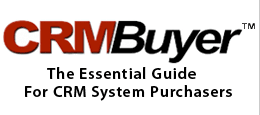That’s it? Only $810.8 million? Not even a whole billion? I would have thought Eloqua would command a higher price, especially with a market cap in the $4-500 million range. Lots of people are saying nice things about the deal but I ain’t buying it just yet.
They IPO’d in August at $11.50 per share and raised $90+ million and in the last year had revenues of about $85 million. So from this perspective the strike price of $23.50 makes some sense. However, marketing automation is heating up and it’s a good place to hang out a shingle these days so I would have expected more of a premium.
This leaves Marketo and a bunch of smaller companies in the space and curiously opens up the market quite a bit. Eloqua is a good Salesforce partner but you have to wonder how much longer that will last given that Larry doesn’t even invite Marc to OpenWorld any more.
I think Eloqua’s Salesforce business goes in the tank immediately meaning that Oracle might have over paid given Eloqua’s revenue is somewhat dependent on good relations between the two companies’ sales forces. So look for Marketo to get a lot more interest from Salesforce (as if they don’t have enough?).
This acquisition clears the field for Salesforce and I could easily see Marc buying Marketo just to make sure he has something in the corral. If that doesn’t happen, then every SAP and IBM in the world will want Marketo and soon. Marketo would be a good fit for Salesforce, better than Eloqua in some respects, given the social direction of the Marketing Cloud.
At this stage Oracle is amassing an impressive string of software solutions that it is attempting to forge into some kind of suite. But maybe not. This reminds me that the last couple of years worth of Oracle acquisitions in the front office market resemble another spate of acquisitions the company embarked on in 2004-2005. It ended up buying such names as PeopleSoft and Siebel and each of those companies had bought up many other companies like J.D. Edwards and Upshot to name just two. I think of that as the Great Consolidation. Lately things are looking similar.
Seven or eight years ago Oracle was chided for becoming the new Computer Associates and it was widely expected to cease all development and enhancement of the products and just collect the maintenance revenue stream. That didn’t happen, the company pledged to keep the brands going and today they are. It also promised to build powerful software that would link everything together in one big, happy mass. The project was supposed to take 3 years but it reached double that before Oracle threw up its hands and declared victory in a parallel universe.
Fusion is still evolving and the separate applications are, well, separate. But the focus now seems to be on bringing together RightNow, Siebel, ATG, Eloqua, and the other recently acquired systems under the Fusion umbrella. Maybe it will work, I dunno.
For now, Oracle may have stolen first base buying Eloqua. The marketing market is still hot, Salesforce is committed to big time social marketing, Marketo might be a target purchase for them but that’s not certain. Sooner or later Oracle needs to put some stories together about how its new applications all work together otherwise the CA rumors will start all over.
 CRM Magazine/destinationCRM.com
CRM Magazine/destinationCRM.com CRMBuyer
CRMBuyer ForecastingClouds
ForecastingClouds InSide CRM
InSide CRM SearchCRM
SearchCRM Animal Spirits
Animal Spirits Butterfly Economics, Paul Ormerod
Butterfly Economics, Paul Ormerod Competing on Analytics: The New Science of Winning
Competing on Analytics: The New Science of Winning Crowdsourcing
Crowdsourcing Dealing with Darwin, Geoffrey Moore
Dealing with Darwin, Geoffrey Moore Hello, Ladies! Dispatches from the Social CRM Frontier
Hello, Ladies! Dispatches from the Social CRM Frontier Origin of Wealth: Evolution, Complexity, and the Radical Remaking of Economics
Origin of Wealth: Evolution, Complexity, and the Radical Remaking of Economics Strategy and the Fat Smoker
Strategy and the Fat Smoker The Black Swan
The Black Swan The Wisdom of Crowds
The Wisdom of Crowds Twitter
Twitter